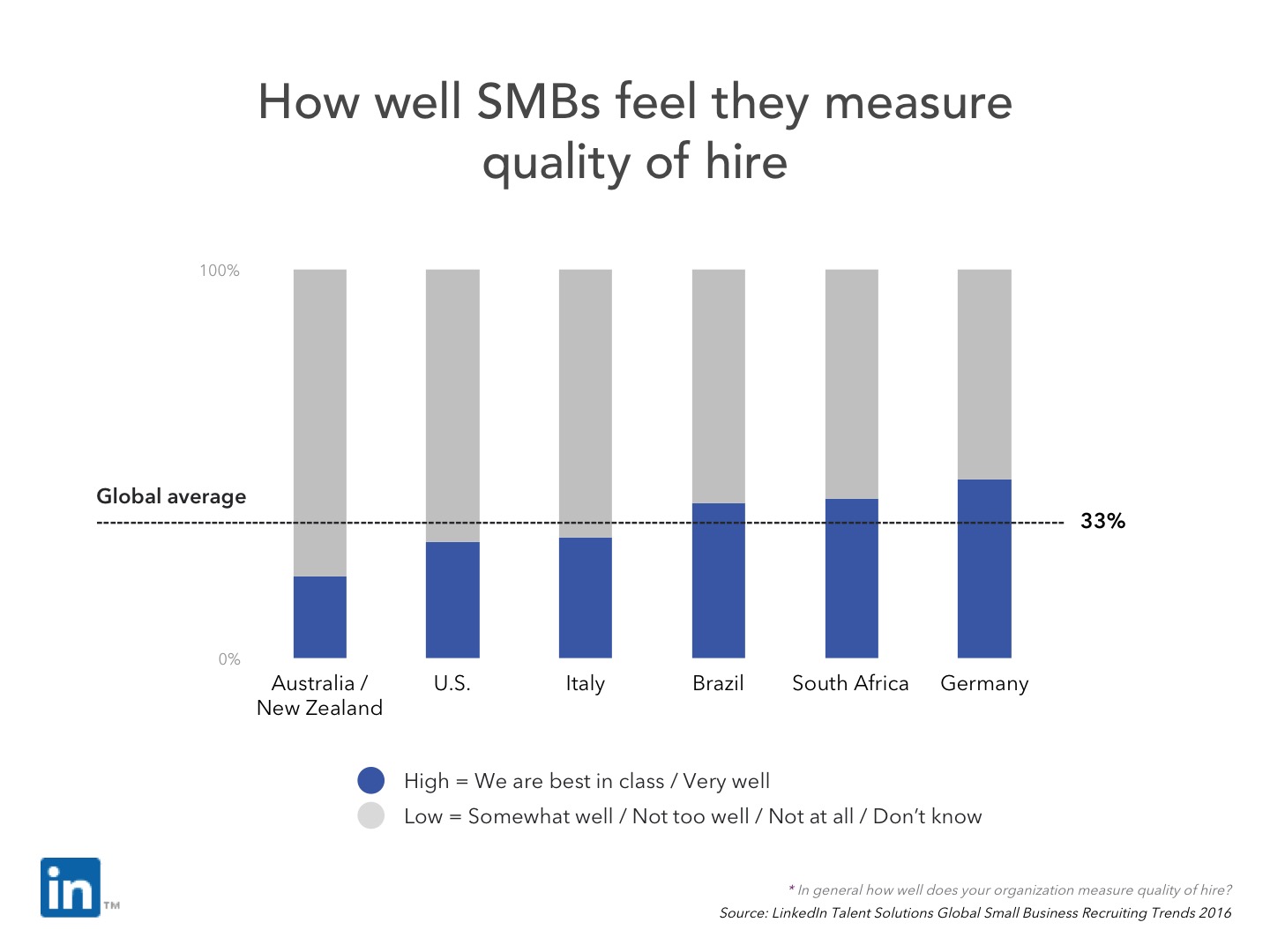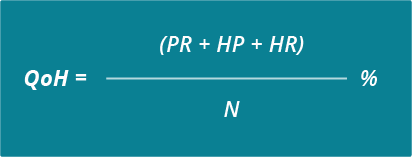How to measure quality of hire
The quality of hire (QoH) is a measure of the value new hires bring to a company, typically gauged by their contribution to the company's long-term success. It's a complex metric, often measured months after hiring, using various indicators like new hire performance metrics, turnover and retention rates.

Unsurprisingly, quality of hire is at the top of the list of useful performance KPIs. According to LinkedIn’s 2016 global trends report, it’s a priority for 40% of big companies worldwide (and 45% of small businesses). Efficiency recruiting metrics, like time to fill and time to hire, are trending up, but there are obvious reasons for why quality of hire is still so important.
Quality of hire is what makes the recruiting process worthwhile. Many companies focus on building a fast and cost-effective recruiting process. But, hiring for efficiency doesn’t necessarily translate into good hires and business success.
So, what exactly is quality of hire?
DEFINITION
Quality of hire (QoH) measures the value new hires bring to a company.
In this context, ‘value’ usually means how much a new hire contributes to their company’s long term success by completing tasks, improving their work and helping others.
QoH is a difficult metric. It has a long term horizon and you can only measure it many months after you’ve made a hire. Also, reliable measurements need standardized formulas. Quality, in contrast, is often vague and subjective. In fact, most companies that LinkedIn surveyed for its recent global trends report, don’t really feel confident about the way they measure QoH:

The best way to measure QoH is by proxy. There are quantifiable recruitment metrics that indicate quality. Let’s call those metrics ‘indicators.’
According to LinkedIn’s report, these are the three most common indicators that companies use:
- New hire performance metrics are used by 51% of companies. They are the most popular way of measuring quality of hire. Performance metrics include any kind of measurements that indicate a new hire adds value, like meeting X sales quota, delivering Y number of product units or achieving Z customer satisfaction ratings.
- Turnover and retention metrics are used by 48% of companies. They give an indication of whether new hires are good fits. They’re risky metrics though, because attrition might have other causes like an ineffective onboarding process or ineffective management practices.
- Hiring manager satisfaction ratings are used by 41% of companies. They show how impressed hiring managers are with the quality of their company’s hiring process and their eventual hires.
Some companies use other indicators like percentage of new hires who were promoted (within a certain time period) or ramp up time (the time it takes for a new hire to reach full productivity compared with the average time).
With your chosen indicators in mind, you could calculate QoH for a new hire through a formula that produces the average of a number of indicators:

For example:
QoH = (New hire performance + new hire engagement + culture fit)/3
QoH = (80% + 85% + 90%)/3
QoH = 85%
Note that, turnover and retention rates refer to the entire organization, so they aren’t used to measure individual quality of hire.
You can also measure overall QoH, through the QoH index. This index will reflect overall quality of hires within your company in the past year. It’s a good way to discover whether your general recruiting and onboarding processes work well. The following formula calculates an average. It takes into account the average QoH of all new hires and the new hire retention rate:

Retention rate can be easily calculated on its own or as a function of turnover rate:
Retention rate (%) = 100 – turnover rate
A common variation of the QoH index is:

Where:
- PR: Average job performance of new hires (e.g. 80 out of 100 based on quantifiable targets or hiring managers’ feedback)
- HP: percentage of new hires reaching acceptable productivity within a determined period
- HR: retention rate after a year
- N: number of indicators (in this case, N=3)
An example QoH index could be calculated like this:
QoH index = (PR + HP + HR)/3
QoH index = (70 + 80 + 90)/3
QoH index = 80
This indicates the average quality of all new hires in a given period (usually a year).
Note that retention and turnover rates can be deceptive. They might not indicate quality of hire, but rather the quality of workplace, manager or onboarding process.
Contents
Pre-hire quality
So far we have looked into how to measure post-hire quality of hire. It’s essential to measure this in the long term, so you can know how successful your new hires are.
But, QoH has another dimension: pre-hire quality. Pre-hire quality assessments are short-term and are meant to predict quality of hire. They are the basis of an effective interview process and reflect everything companies can do to select the best candidates. Lou Adler, author and founder of The Lou Adler Group, a consultancy firm that helps companies use performance-based hiring, says that all factors of QoH can be assessed before companies make a hire. He has developed a talent scorecard that can help companies predict QoH.
Other factors can help predict QoH too. For example, candidates who score well on tests and assessments are more likely to be successful hires. Also, optimizing recruiting metrics, like cost per hire and candidate per hire can make the process more efficient. And a more efficient process can help recruiters and hiring managers focus on quality.
Use a mix of different recruiting sources to find high-quality candidates. Download our free sourcing guide to find out how.
How to collect data
Collecting data on turnover and retention rates is relatively easy. So is quantifying concrete performance goals, like “this new hire generated X sales leads in a year.”
But, other calculations can be less transparent. For example, hiring manager satisfaction surveys aren’t normally recorded as part of everyday operations. And calculating time to full productivity (which companies can use in quality of hire calculations) can be tough. It requires companies to clearly define what ‘time to full productivity’ means and consistently keep track of new hires’ work from the beginning.
Surveys can be a good solution to gather necessary data. They come in various forms:
- Hiring manager satisfaction surveys (focusing on the recruitment process)
- Surveys asking managers to rate a new hire’s performance (e.g. 6- and 9-month performance surveys)
- Employee engagement surveys for new hires
- 360 surveys asking managers, peers and team members about a new hire’s culture fit and performance
- Surveys asking hired or rejected candidates to give feedback on the hiring process
As expected, there’s a great deal of subjectivity in all of these surveys. But, quality is often subjective.
Use QoH to make comparisons
QoH can be useful on its own. For example, if your QoH was 65% last year and it jumped up to 90% this year, you have grounds for celebration.
But, QoH can be used to make even more useful comparisons. For example, connecting QoH with other metrics like source of hire can be good for adjusting recruiting strategies to get more return on investment (ROI) from different sources. If the hires with the highest QoH come from X job board or Y recruiting agency, you’ll be able to make a sound business case for investing more in those recruiting channels. Conversely, you could also justify a decision to stop collaborating with an agency that consistently sends you lower quality hires.
You can also use QoH to determine the strategic impact of the recruiting process. For example, you can determine whether QoH translates into increased revenue or higher overall productivity. And HR metrics like revenue per employee can help you get more granular.
Industry comparisons aren’t likely to work for this metric, though. There’s too much inconsistency in how each company measures QoH. It also wouldn’t really matter if your company had the highest QoH in your sector, if the overall quality level in the sector was low.
Start with the basics
There are a few things you should do to measure QoH effectively:
- Decide which indicators you’ll use to measure QoH
- Define objectives for each position and communicate them clearly to candidates and new hires, through a well-written job description
- Build an effective onboarding process
- Train managers to coach and motivate new hires
- Choose, craft and administer effective surveys
- Make a commitment to communicate metrics to your entire company
Frequently asked questions
- Why is the quality of hire important?
- Quality of hire is a vital recruitment metric as it signifies the value that new hires bring to your organization, particularly their contribution to long-term success.
- What is the Interview to Hire Ratio?
- The Interview to Hire Ratio is a benchmark that indicates the number of candidates an interviewer needs to meet before selecting one for the position. A ratio of 3:1 or better is generally considered efficient.
- What are the qualities of a good employee?
- A good employee is reliable, consistently completing tasks, and can be depended upon to solve problems when they arise.
- How can the quality of hire be measured effectively?
- To measure the quality of hire effectively, you should decide on the indicators to use, define clear objectives for each position, build an effective onboarding process, and train managers to coach and motivate new hires.
- What is the role of surveys in measuring the quality of hire?
- Surveys, such as hiring manager satisfaction surveys and employee engagement surveys, can be used to gather necessary data for measuring the quality of hire, despite the inherent subjectivity in these surveys.



